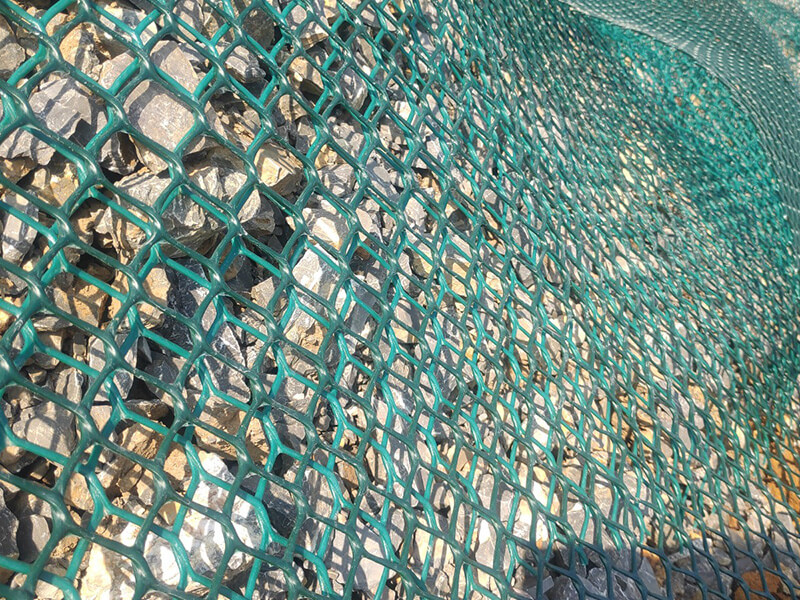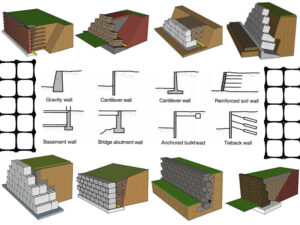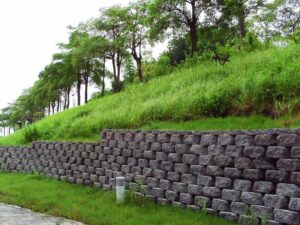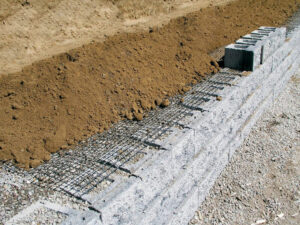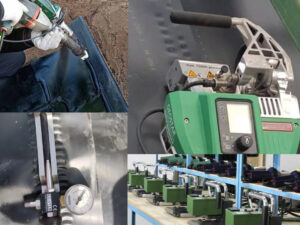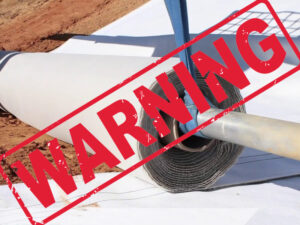Geonets is a kind of material that is made of multiple ribs intersecting at different angles and spacings. When geotextile is pressed on one or both sides of the geonets, it is called a drainage geocomposite.
Geonets has a very wide range of applications and produce very good results.
In this article, we will introduce the application of geonets in detail.
Table of Contents
Advantages of Geonets
Geonets is made of high-density polyethylene (HDPE) and anti-ultraviolet additives and has the characteristics of anti-aging and corrosion resistance.
It is mainly used for engineering applications such as soil reinforcement, soil protection, and soil stabilization.
It can effectively enhance the tensile strength, shear strength, and anti-scouring ability of the soil, and improve the stability and bearing capacity of the soil.
1. High strength: Geonets is made of high-strength synthetic fiber or plastic material, with high tensile strength and shear strength, which can effectively enhance the mechanical properties of soil.
2. Water permeability: The mesh structure of geonets has a certain porosity and water permeability, which can promote water penetration and drainage and reduce the penetration resistance of soil.
3. Anti-scouring ability: Geonets can effectively prevent soil erosion and hydraulic impact, improve soil anti-scouring ability, and protect soil and water resources.
4. Durability: Geonets is usually made of synthetic fiber or plastic material with good weather resistance, good durability and anti-aging performance, and can be used for a long time.
5. Environmental protection and energy saving: Geonets can reduce the amount of soil excavation and filling, reduce the consumption of soil resources in the project, and realize the rational use
and conservation of land.
6. Convenient construction: Geonets is soft and easy to bend, easy to construct, and can adapt to the requirements of projects of different shapes and complex terrains.
7. Easy maintenance: The maintenance of geonets is relatively simple, generally only regular cleaning and inspection are required, and the maintenance cost is low.
The application of geonets mainly includes the following aspects:
River embankment protection, coastal management, tunnel engineering and laying of breakwater diversion dams, etc.
1. Protection of embankments and rock surfaces to prevent erosion, and avoid landslides, loose rocks and soil erosion, can be made into gabions for use;
2. Sea and river bank engineering and seaway engineering, with strong flexibility, good permeability, not eroded by seawater, and can absorb wave impact;
3. Can be made into rectangular, square or tubular gabions and installed directly underwater without expensive diving operations.
Roadbed reinforcement
Granular fillers and geogrids are interlocked to form a stable plane to prevent fillers from sinking and disperse vertical loads; multi-layer reinforcement can be used in areas with harsh geographical conditions.
1. Prevent cracks in the roadbed and avoid landslides.
2. Strengthen the foundation, and embankment slope, improve roadbed stability, and reduce floor space;
3. Can withstand heavy loads;
4. Shorten the construction period; Geonets specifications and performance parameters
Under harsh environmental conditions, it can also be constructed.
Pavement reinforcement
The integration of geogrid and pavement materials can effectively disperse and transfer loads and prevent pavement cracks.
1. Enhance pavement stability and prevent cracks;
2. Can withstand large variable loads;
3. Can prevent pavement cracks caused by slurry overturning;
4. Can reduce the amount of pavement materials and speed up construction.
Realize three-dimensional mesh slope protection technology
The advantages of geogrid combined with vegetation slope protection can effectively solve the protection problems of rock slopes and high and steep slopes.
Through the growth activities of plants, the purpose of root reinforcement and stem and leaf erosion prevention is achieved, forming dense vegetation coverage, effectively inhibiting the erosion of rainstorm runoff on the slope, increasing the shear strength of the soil, and reducing the pore water pressure and soil self-weight.
Thereby greatly improving the stability and anti-scouring ability of the slope.
More uses of geonets
1. Soft foundation treatment, roadbed reinforcement, slope protection, bridge abutment reinforcement, coastal slope protection, reservoir bottom reinforcement and other projects.
2. Laying geonets on road slopes can prevent rock blocks from sliding and causing harm to people or vehicles.
3. Wrapping ballast with geonets can prevent ballast loss and roadbed deformation, and improve roadbed stability.
4. Laying geonets can reinforce the road surface and prevent the development of reflective cracks.
5. Geonets are used as reinforcement materials in retaining wall fill to disperse soil stress, limit lateral displacement, and enhance stability.
6. Using geonets to make gabions for the protection of embankments and rock surfaces can prevent erosion, landslides, and soil erosion.
Application cases of geonets
The three-dimensional geonet spraying and grass seeding technology is installed on the slope.
Net slope protection uses active plants and engineering materials such as geosynthetics to build a protection system with self-growth ability on the slope.
Through the growth activities of plants, a dense vegetation cover layer is formed on the slope, and a tangled root system is formed in the topsoil layer.
This effectively inhibits the erosion of the slope by rainstorm runoff, increases the shear strength of the soil, reduces the pore water pressure and the self-gravity of the soil, and thus greatly improves the stability and anti-scouring ability of the slope.
The three-dimensional vegetation net slope protection technology combines the advantages of geones and plant slope protection and plays the role of composite slope protection.
When the vegetation coverage rate of the slope reaches more than 30%, it can withstand the erosion of light rain, and when the coverage rate reaches more than 80%, it can withstand the erosion of heavy rain.
When the plants grow luxuriantly, the runoff flow rate that can resist erosion reaches 6m/s, which is more than twice that of ordinary turf.
The existence of geonets has a good effect on reducing the evaporation of water in the slope soil and increasing the infiltration.
At the same time, because the geonets material is black polyethylene, it has the function of heat absorption and heat preservation, which can promote seed germination and is conducive to plant growth.
The anti-erosion effect of vegetation is achieved through its three main components:
1. Plant growth layer (including perianth, leaf sheath, leaf blade, stem)
Through its own dense coverage, it prevents the surface soil of the slope from being directly eroded by rainwater, and reduces the scouring energy of rainstorm runoff and the surface runoff velocity, thereby reducing soil loss;
2. Humus layer (including the interface between the fallen leaf layer and the rhizome)
Provides a protective layer for the surface soil of the slope;
3. Root layer
This part reinforces and anchors the surface soil of the slope and provides mechanical stability.
Generally speaking, in the early stage of plant growth, since the roots formed by individual plants are only loosely entangled, there is no long-lying root system, which is easy to separate from the soil layer and cannot play a protective role.
The application of geonets is to achieve more thorough shallow protection by enhancing the effects of the above three aspects.
1. Increase its protective performance and mechanical stability within a certain thickness range.
2. Due to the existence of geonets, the huge root system of the plant is connected to the mesh of the geonets to form a plate structure (equivalent to the reinforcement of the surface soil of the slope).
This increases the tensile strength and shear strength of the protective layer, limits the expansion of the “gradual destruction” caused by erosion (erosion will directly damage a single plant, and the damaged area will increase over time), and ultimately limits the occurrence of shallow surface sliding and uplift of the slope.
Characteristics of three-dimensional geonets spraying and grassing protection
1. Strengthen the stability of the slope:
After the implementation of spraying and grassing, the vegetation and the three-dimensional geonets are connected to form a surface network system, and are fixed on the slope through U-shaped nails/anchors and roots (deepening into the original slope depth).
The slope surface, three-dimensional geonets, vegetation and anchors together form a slope protection system, which greatly enhances the stability of the slope.
2. Targeted:
This slope protection technology is mainly suitable for the greening of earth slopes with a slope ratio of H≥1:0.3 and weakly weathered stone slopes, especially for road cutting rock slopes with a slope ratio steeper than 1:0.5.
Compared with other greening methods, the three-dimensional vegetation net spraying and grassing greening method has obvious advantages. If it is separated from engineering measures, this method can also be used for unstable rock slopes.
However, from an economic point of view, the cost of this method is relatively low, so it has a certain degree of targeting.
3. Improve the ecological environment.
The main function of the organic substrate is to improve plant growth conditions, provide a base for plant growth, restore the natural vegetation on the slope, improve the environmental landscape of the slope, and meet current environmental protection requirements.
Construction procedures and construction technology
1. Construction procedures
Clear the slope → Fix the three-dimensional geonets → Drive U-shaped nails → Irradiate organic substrate → Spray grass seeds → Cover with non-woven fabric → Maintenance management
2. Construction technology
(1) Slope cleaning and leveling
Generally, artificial methods are used to clean up floating stones and loose soil on the slope, and the slope after the treatment is uneven, flat, without large stones protruding and other debris, which is conducive to the natural separation of the base material and the rock surface.
(2) Install anchor rods (depending on the soil quality: anchor rods are required for weathered rock layers/granite, and more than five layers of three-dimensional geonets are hung)
Anchor rods can be divided into long anchor rods and short anchor rods. The length of long anchor rods is 1 to 1.5 meters, and the length of short anchor rods is 0.5 to 0.8 meters. Generally, short anchor rods are made of threaded steel with a diameter of ф12 mm.
When installing anchor rods, first lay out the long anchor rods and short anchor rods in parallel, with a horizontal spacing of 2 meters and a vertical spacing of 4 meters. Then use a pneumatic drill or an electric drill to drill holes. The diameter of the drill bit is generally ф25 mm, and the drilling depth is the same as the length of the anchor rod.
After the hole is drilled, the anchor rod can be fixed. The anchor rod must be treated with rust prevention in advance and poured with cement mortar. When pouring cement mortar into the anchor hole, it must be filled and solid. The length of the anchor rod extending out of the slope is 4 to 6 cm.
(3) Fixing the three-dimensional geonets
1) Laying: Lay the three-dimensional vegetation net on the slope from top to bottom. The overlap length between the front and rear nets is greater than 10 cm, and the net and the slope surface are kept smoothly connected;
2) Pre-embedded: The three-dimensional geonet should extend 50 cm from the top of the slope. If the intercepting ditch on the top of the slope is not built, it is best to place it under the mortar masonry on the top of the slope. There should also be 20 cm of three-dimensional geonet buried in the platform fill at the bottom of the slope
3) Anchoring: Fix the three-dimensional net from bottom to top with U-shaped steel bars of ф6 mm or more. The U-shaped steel bars are about 15 to 30 cm long and 8 cm wide. The spacing between the U-shaped steel bars is about 1.5 to 2.5 meters. Use 8﹟U-shaped iron nails or bamboo nails in the middle for auxiliary fixing.
(4) Spraying organic substrate
The organic substrate is composed of vegetation sandy loam, sawdust, organic fertilizer and compound fertilizer. The weight ratio is 10:0.06:0.01:0.0012.
After the preparation is ready, use a sprayer to spray the evenly mixed organic substrate on the slope.
Spraying should be stopped from the front as much as possible. The concave and convex parts and dead corners should be sprayed sufficiently. The uniform thickness of the spray is 10 to 15 cm.
There should be 3 to 5 cm of substrate above the three-dimensional net.
The thickness of the spray can be adjusted according to the rock properties of the slope to ensure that the organic substrate can provide sufficient nutrients and water for lawn growth.
(5) Spraying grass seeds
After the base material is sprayed, wait for it to dry naturally for 4 to 12 hours before spraying grass seeds on the surface.
Spraying grass seeds uses the most advanced spraying method currently, namely hydraulic spraying technology, also known as “hydraulic seeding”.
Its principle and operation method is to use mechanical power and hydraulic transmission to dissolve the seed adhesive (also known as soil improver) that promotes seed germination and seedling growth, pulp fiber, compound fertilizer, water retaining agent, grass seeds and a certain amount of clean water in the sprayer and stir them mechanically to form a uniform mixture. Then, through the action of a high-pressure pump, the mixture is evenly sprayed on the treated slope at high speed, attached to the surface and soil seeds to form an organic whole. It integrates bioenergy, chemical energy and mechanical energy, and has the advantages of high efficiency, low cost, low labor intensity and fast completion.
(6) Covering with non-woven fabric
Covering the surface of the spraying with non-woven fabric reduces the erosion of seeds caused by heavy rainfall, and also reduces the evaporation of water on the surface of the slope, thereby further improving the germination and growth environment of the seeds.
(7) Maintenance and management
Regular watering and maintenance shorten the period of turfing.
In the end
The above is a detailed introduction to the advantages, applications, and cases of geonets.
QIVOC now offers geonets with low prices and good quality. If you are interested in this, please feel free to contact us.

